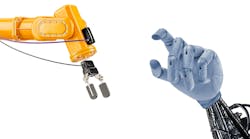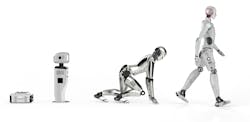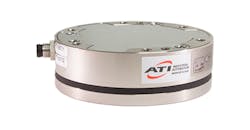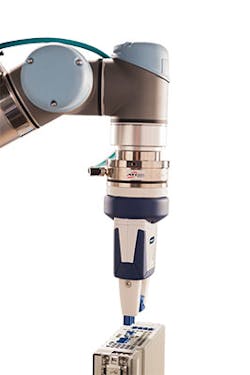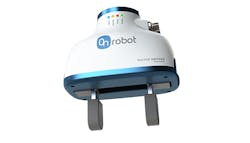For some reason, I can't think about the sixty or so years of industrial robotic evolution without drawing parallels to our own comeuppance from crude pre-Australopithecus primate to the ambitious innovators we are today. We didn’t get to the point of building megalopolises and sending satellites past the outer rungs of the solar system by being the biggest and strongest, but through advanced brains and dexterous hands. Likewise, those two attributes are responsible for industrial robots' current explosion in capabilities. Instead of highly developed cerebral cortices and opposable thumbs, though, these multi-axis robots rely on software, algorithms, and the next generation of end-arm tooling.
These advancements, specifically in end-effector offerings, will be quite apparent at the International Manufacturing Technology Show 2018 in Chicago (Sep. 10-15). Showcasing ingenuitive motion and heightened sensitivity, this new species promises to work smarter, not harder while manipulating the tiniest of components.
Origin of Automated Species
The 1980s began with General Motors chairman Roger B. Smith predicting robots would replace humans as wages rose. A dollar an hour hike would lead to a thousand more robots on the factory floor. Reality proved his math was off, and by the end of the decade, robot sales were in decline.
"There was stagnation, and robots weren't selling in the way everybody thought they would," recalls Robert Little, CEO of ATI Industrial Automation.
It's not that the idea of robots was flawed, as they could weld and handle heavy materials, but something was missing: versatility. Humans could learn to do pretty much whatever is asked of them, while robots were fixed, hardwired, inflexible, and due to limited choices for end effectors, severely lacking in dexterity, an area in which people excel. Often powered by hydraulics, the robots had a gorilla-like grip.
That's why Little, along with fellow engineers Keith Morris and Dwayne Perry founded ATI in 1989.
"We had a mission to develop end effectors that could survive the harsh treatment robots give them," says Little, who started as ATI's COO. "We built ourselves on engineering bullet-proof end effectors, and it worked. The quality went up, and our sales started to rise. It made robots easier to use and increased robot sales in general."
New robot installations in America did steadily increase in the early 90s, nearly doubling from 1993 to 1995, when the market first crossed the 10,000 unit threshold. How much of that can be attributed to end effectors is debatable, but what's not is that the robot attachments grew in quality and capability. Grippers, now powered by pneumatics, picked up parts with greater precision.
Adding force-torque sensors led to better feedback, further refining accuracy, and repeatability. Interestingly, six-axis force/torque sensors were used as far back as 1973 at NASA's Jet Propulsion Laboratory, as this excerpt from a JPL research paper shows:
The drive motor torque required to achieve the link angle/time function is then computed based on a model of the manipulator hardware. The motor voltage/torque characteristic is also modeled, and the computed torque is converted to applied motor voltage. This voltage is computed at a very high rate, applied to D/A converter, and finally to the motor input.
ATI, now a global leader in six-axis F/T sensors, has improved exponentially upon the initial concept, culminating in the Axia80. The high-powered, compact attachment couples to the robot arm and can fit a number of end effectors to increase dexterity. Whereas traditional robots are seen as mechanical and rigid, attaching an Axia80 enables acute responsiveness that is ideal for high precision operations.
This makes them the perfect accessory for collaborative robots. The Axia80 works with leading cobot manufacturer Universal Robots' UR-3, 5, and 10.
Cobots, such as the new E-series UR models, do include F/T sensors already, but the Axia80 sensor is up to five times more accurate, with as much as twenty times the resolution.
“It's always good to ensure you have the best force sensor available," Little explains. "The Axia80 detects something as simple as a finger caught underneath a part."
In this respect, the creation has surpassed the creator. Although a human hand may cause a tiny amount of deflection, the Axia80 can sense these minimal variations and signal the robot to react.
Keeping all workers safe is a top priority of any automated cobot system, with an improved quality close behind. F/T sensors are able to improve safety and process flexibility simultaneously. Better sensing makes way for a wider variety of applications; which is excellent for those who invest in robotics. As technology keeps moving forward, there will be more and more opportunities for robots and humans to work together safely and efficiently.
Unlike the envisioned of GM's chairman, the jobs these robots take are not the ones people will miss. A worker would be much better suited to managing several machines and talking to current or prospective customers rather than shaving and polishing a metal widget.
"Robots always succeed in doing work people don't want to do," Little says.
Parallel (Gripper) Evolution
Three decades of experience support ATI's initiatives. Innovation can come from anywhere at any time though, even from a company that has existed for about three months. That's how old OnRobot is. The Denmark-based end-effector and sensor manufacturer fused three startups together—from Denmark, Hungary, and the United States—to bring machine shops and other automation users three new solutions for tending and assembly.
"They go hand-in-hand with the collaborative mindset of easy programming, flexible equipment, and being able to use robots in different tasks," says Kristian Hulgard, OnRobot's general manager for the Americas.
Expect the Gecko Gripper to generate the most buzz. Not to be confused with the biomimetic grippers Festo has become known for, this attachment doesn’t immediately resemble a Gecko's foot, though it works the same, using a quantum dynamics phenomenon called the van der Waals force. It's complicated, but the short explanation is that it creates a polarity, and weak attraction, between two objects. Like the early force-torque sensors, it was developed by NASA's JPL, this time as an alternative to Velcro.
"The Gecko gripper works completely different than anything we've seen on the automation market," Hulgard asserts. Select customers have used it on steel, glass, plastic bags, and even printed circuit boards (PCBs).
The RG2-FT smart gripper, an evolution of the previous RG-2 and RG-6 servo grippers, employs a six-axis force-torque sensor in each "fingertip."
"We can now [be used in] new tasks and start being intelligent," Hulgard says. "We give the robots so much feedback and intelligent sensing that it's opening up new doors."
One of these is in circuit board assembly.
"Imagine if you need to put a pin in a very tight hole, and use your wrist, not your fingers," Hulgard says.
Built-in proximity sensors also zero in on the part before touching it to ensure a proper grip automatically.
This also allows the West to tighten its grasp on electronics manufacturing, which cheaper labor in Asia has wrested away.
"By giving robots the sensing abilities and being able to automate more, that gives us the competitive advantage," Hulgard says. "This keeps jobs and keep manufacturing where we want it."
The final offering, the Polyskin Tactile Gripper, uses sensors on the fingers to offer a less refined, but effective solution for assembly and bin picking. Some features include individual alignment of each finger and bump detection. It's ideal for sensitive or irregular workpieces.
The economical alternative "might not have all features, but you get the major functionality, such as force control and variable grip distance," Hulgard says.
OnRobot's RG-2 and RG-6 servo grippers, along with the Dual RG2 Dual gripper, have been out for about three years. The Dual Gripper specifically has cut cycle time by 40% and helped a Danish high mix, low volume machine shop save time and money.
They noticed how inefficient it was for a robot to remove the finished part from the machine and set it down before picking up the next part to work on.
"When we put two grippers on, we could grip and place the object in the machine in the same cycle," Hulgard says. "That cuts out a movement in and out of the machine."
Hulgard stresses that as humanlike these end-effectors are making cobots' "hands," they are augmenting the workers, and allowing for more work to be done.
As cobots' brains evolve to a more general intelligence in the next decade, that could all change, and human workers will just have to change, too. Survival of the fittest and all that. But that's an argument for another time.
What isn’t up for debate is how any company using or planning to use the current wave of cobots, needs to be just as adept at knowing what end-effectors are available for their specific solution.
"The choice of end effector will start to mean more and more," Hulgard says. "Now we're in that time where we have to educate the market and show them these new possibilities."










